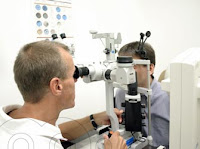
Research group led by Christoph J. Binder on CeMM Research Center for Molecular Medicine of the Austrian Academy of Sciences and at the Medical University of Vienna, has deciphered a mechanism in the pathogenesis of age-related macular degeneration, which was previously unknown. This opens great opportunities for new therapies, one of the hardest to develop eye diseases.
Age-related macular degeneration (AMD) is the leading cause of blindness in the western world. The pathogenic processes were largely unknown. The scientists have now shown that a commonly occurring metabolite of endogenous molecules, known as the malondialdehyde (MDA) in the pathogenesis of AMD plays an essential role and how that harm can be done.
Mechanism identified, the MDA makes harmless
By oxidative stress in the retina leads to the accumulation of potentially harmful degradation product malondialdehyde. First author David Weismann, Ph.D. student at CeMM could now identify those defense mechanism, the malondialdehyde (MDA) in the healthy organism and mediates the removal of patulin. The results of the study, which can significantly contribute to finding new therapies have been published in the latest issue of "Nature", one of the absolute top magazines worldwide.
"Sensational Success"
Giulio Superti-Furga, scientific director of this scientific breakthrough CeMM said: "I am particularly pleased that the young team led by Christoph Binder has become such a sensational success. An article in Nature is the world's greatest objective recognition of an individual research performance and Austrian scientists produce more than a few such articles a year. Christoph Binder's performance reinforces the vision of the Austrian Academy of Sciences and the Medical University to build on and at the Medical University of Vienna CeMM best conditions for young people and to conduct basic and clinically relevant research at the highest level. "
"This is a milestone in the study of age-related macular degeneration, which is also international attention. The Medical University of Vienna is once again demonstrated its good international reputation, "says Wolfgang Schütz, Rector of the Medical University of Vienna.
In the multi-year study on CeMM and the Medical University of Vienna, also attended by scientists from the University of San Diego, the University of Jena and the Johns Hopkins University participated was shown that one of the most common proteins neutralized in the blood plasma, the complement factor H, the harmful malondialdehyde and thus prevents inflammation. This function of the complement factor H in the body's defense was so far unknown. Variations in that gene that encodes factor H result in an ill seven-to nine-fold increased risk of AMD.
Binder's research group has now shown that the risk variant of complement factor H can only inadequately protect against the damaging effects of MDA and so increases the risk of disease. Binder: "The results are a further confirmation of the hypothesis that the innate, endogenous defense fought not only bacteria and viruses effectively, but also protects against harmful processes within the body." Oswald Wagner, Vice Rector of the Medical University of Vienna and Director of the Clinical Institute for laboratory medicine: "We can already testing on patients, whether this mutation and thus are at increased risk."
CeMM (Research Center for Molecular Medicine of the Austrian Academy of Sciences) - Short Profile
The CeMM is an international, independent and interdisciplinary research center for molecular medicine. "From the clinic to the hospital" - the CeMM oriented to the medical requirements and integrates basic research and clinical expertise to develop innovative diagnostic and therapeutic approaches. The research focuses on cancer, inflammation and immune disorders.
Info: www.cemm.oeaw.ac.at.
Medical University of Vienna - Short Profile
The Medical University of Vienna (in short: MUV) is one of the most traditional medical training and research centers in Europe. With nearly 7,500 students, it is now the largest medical training facility in Germany. With its 31 university hospitals, 12 medical centers and numerous theoretical highly specialized laboratories, it is also among the top research institutions of Europe's most important in the biomedical field. For clinical research are about 48,000 m² of research space available.
Wednesday, October 12, 2011
CeMM and MUV decode mechanism for age-related macular degeneration
Labels:
eye disease,
macular degeneration
Subscribe to:
Post Comments (Atom)
0 comments:
Post a Comment